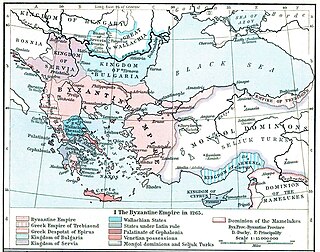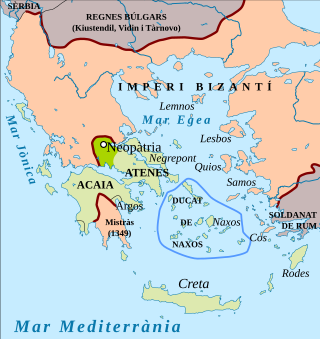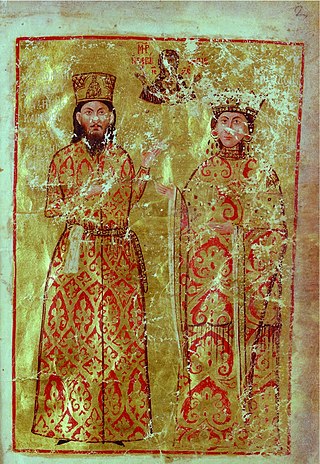
Michael VIII Palaiologos or Palaeologus reigned as Byzantine emperor from 1261 until his death in 1282, and previously as the co-emperor of the Empire of Nicaea from 1259 to 1261. Michael VIII was the founder of the Palaiologan dynasty that would rule the Byzantine Empire until the Fall of Constantinople in 1453. He recovered Constantinople from the Latin Empire in 1261 and transformed the Empire of Nicaea into a restored Byzantine Empire. His reign saw considerable recovery of Byzantine power, including the enlargement of the Byzantine army and navy. It also included the reconstruction of the city of Constantinople, and the increase of its population. His re-establishment of the University of Constantinople contributed to the Palaeologan Renaissance, a cultural flowering between the 13th and 15th centuries.
The Battle of Pelagonia or Battle of Kastoria took place in early summer or autumn 1259, between the Empire of Nicaea and an anti-Nicaean alliance comprising Despotate of Epirus, Kingdom of Sicily and the Principality of Achaea. It was a decisive event in the history of the Eastern Mediterranean, ensuring the eventual reconquest of Constantinople and the end of the Latin Empire in 1261.

The despot of Epirus was the ruler of the Despotate of Epirus, one of the successor states of the Byzantine Empire in the aftermath of the Fourth Crusade. The name "Despotate of Epirus" and the title "despot of Epirus" are modern historiographical names, and were not in use by the despots themselves. In the Byzantine Empire, the title of despot was a prestigious court title and did not designate rule over some specific territory. Though several of the early Greek rulers of the Epirote realm did use the title of despot, it was never in reference to the lands they governed, but instead in reference to their position in the imperial hierarchy.

Great Vlachia or Great Wallachia, also simply known as Vlachia, was a province and region in southeastern Thessaly in the late 12th century, and was used to denote the entire region of Thessaly in the 13th and 14th centuries. The name derives from the Vlachs (Aromanians), who had lived across much of the area.

Michael II Komnenos Doukas, Latinized as Comnenus Ducas, often called Michael Angelos in narrative sources, was from 1230 until his death in 1266/68 the ruler of the Despotate of Epirus, which included Epirus in northwestern Greece, the western part of Greek Macedonia and Thessaly, and western Greece as far south as Nafpaktos.
The history of Thessaly covers the history of the region of Thessaly in north-central Greece from antiquity to the present day.
John I Doukas, Latinized as Ducas, was an illegitimate son of Michael II Komnenos Doukas, Despot of Epirus in c. 1230–1268. After his father's death, he became ruler of Thessaly from c. 1268 to his own death in 1289. From his father's family he is also inaccurately known as John Angelos.

The Duchy of Neopatras was a principality in southern Thessaly, established in 1319. Officially part of the Kingdom of Sicily, itself part of the Crown of Aragon, the duchy was governed in conjunction with the neighbouring Duchy of Athens, it enjoyed a large degree of self-government. From the mid-14th century, the duchies entered a period of decline: most of the Thessalian possessions were lost to the Serbian Empire, internal dissensions arose, along with the menace of Turkish piracy in the Aegean and the onset of Ottoman expansion in the Balkans. Enfeebled, the Catalan possessions were taken over by the Florentine adventurer Nerio I Acciaioli in 1385–1390. The title of Duke of Neopatras was held by the heir of the King of Sicily.
Licario, called Ikarios by the Greek chroniclers, was a Byzantine admiral of Italian origin in the 13th century. At odds with the Latin barons of his native Euboea, he entered the service of the Byzantine emperor Michael VIII Palaiologos, and reconquered many of the Aegean islands for him in the 1270s. For his exploits, he was rewarded with Euboea as a fief and rose to the rank of megas konostaulos and megas doux, the first foreigner to do so.
John Doukas Palaiologos was a Byzantine aristocrat, brother to Emperor Michael VIII Palaiologos, who served as the commander-in-chief of the Byzantine army. He played a prominent part in his brother's military campaigns, most notably in the crucial victory at the Battle of Pelagonia, but also in repeated campaigns against Epirus and against the Turks in Asia Minor. He retired from active service after his defeat at Neopatras, and died shortly after.
George Mouzalon was a high official of the Empire of Nicaea under Theodore II Laskaris.

The Battle of Demetrias was a sea engagement fought at Volos in Greece in the early 1270s between a Byzantine fleet and the assembled forces of the Latin barons of Euboea (Negroponte) and Crete. The battle was fierce, and initially in favour of the Latins, but the timely arrival of Byzantine reinforcements tipped the scale, resulting in a crushing Byzantine victory.

The siege of Berat in Albania by the forces of the Angevin Kingdom of Sicily against the Byzantine garrison of the city took place in 1280–1281. Berat was a strategically important fortress, whose possession would allow the Angevins access to the heartlands of the Byzantine Empire. A Byzantine relief force arrived in spring 1281, and managed to ambush and capture the Angevin commander, Hugo de Sully. Thereupon, the Angevin army panicked and fled, suffering heavy losses in killed and wounded as it was attacked by the Byzantines. This defeat ended the threat of a land invasion of the Byzantine Empire, and along with the Sicilian Vespers marked the end of the Western threat to reconquer Byzantium.

The Battle of Makryplagi or Makry Plagi was fought between the forces of the Byzantine Empire, and the Latin Principality of Achaea. The Byzantines had been weakened and demoralized by the defection of their numerous Turkish mercenaries to the Achaeans. At Makryplagi, the Byzantines suffered a heavy defeat, which together with their defeat at the Battle of Prinitza the previous year ended their attempted reconquest of the Morea.
Michael Palaiologos Tarchaneiotes was a Byzantine aristocrat and general, active against the Turks in Asia Minor and against the Angevins in the Balkans from 1278 until his death from disease in 1284.
Nikephoros Tarchaneiotes was a 13th-century Byzantine aristocrat and general.

John Komnenos Angelos Doukas Synadenos was a Byzantine noble and military leader with the rank of megas stratopedarches during the reigns of Michael VIII Palaiologos and Andronikos II Palaiologos.

The Reconquest of Constantinople was the recapture of the city of Constantinople in 1261 CE by the forces led by Alexios Strategopoulos of the Empire of Nicaea from Latin occupation, leading to the re-establishment of the Byzantine Empire under the Palaiologos dynasty, after an interval of 57 years where the city had been made the capital of the occupying Latin Empire that had been installed by the Fourth Crusade in 1204 following the Crusader Sack of Constantinople.

The Empire of Thessalonica is a historiographic term used by some modern scholars to refer to the short-lived Byzantine Greek state centred on the city of Thessalonica between 1224 and 1246 and ruled by the Komnenodoukas dynasty of Epirus. At the time of its establishment, the Empire of Thessalonica, under the capable Theodore Komnenos Doukas, rivaled the Empire of Nicaea and the Second Bulgarian Empire as the strongest state in the region, and aspired to capturing Constantinople, putting an end to the Latin Empire, and restoring the Byzantine Empire that had been extinguished in 1204.

The Nicaean–Latin wars were a series of wars between the Latin Empire and the Empire of Nicaea, starting with the dissolution of the Byzantine Empire by the Fourth Crusade in 1204. The Latin Empire was aided by other Crusader states established on Byzantine territory after the Fourth Crusade, as well as the Republic of Venice, while the Empire of Nicaea was assisted occasionally by the Second Bulgarian Empire, and sought the aid of Venice's rival, the Republic of Genoa. The conflict also involved the Greek state of Epirus, which also claimed the Byzantine inheritance and opposed Nicaean hegemony. The Nicaean reconquest of Constantinople in 1261 AD and the restoration of the Byzantine Empire under the Palaiologos dynasty did not end the conflict, as the Byzantines launched on and off efforts to reconquer Southern Greece and the Aegean islands until the 15th century, while the Latin powers, led by the Angevin Kingdom of Naples, tried to restore the Latin Empire and launched attacks on the Byzantine Empire.











